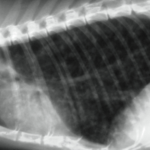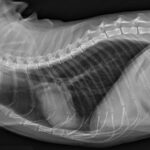
Asthma is a recurring respiratory compromise featuring the constriction of the lung’s airways. First, excess mucus forms, the airway walls swell with inflammation and can actually ulcerate, and finally the airway muscles go into spasm leading to constriction. Airway constriction leads to inability to draw a deep breath, intolerance to exercise, coughing, and musical sighing sounds called “wheezes,” though not all these symptoms may be apparent at the same time. Sometimes a low-grade chronic cough is the only manifested sign but it should be remembered that an acute asthmatic crisis can arise at any time and can represent a life-threatening event. Asthmatic airway constriction can happen spontaneously or as a type of allergic reaction. When it comes to treatment, relieving and preventing airway constriction is what it is all about.
Is Feline Asthma the Same as Human Asthma?
The feline condition was named asthma due to the clinical features shared with the human disease. As of this time, it appears that all the diagnostic criteria needed to make the asthma diagnosis in humans are shared by cats, yet we are still working out the mechanics of this syndrome in the cat and more to learn.
How is the Diagnosis Made?
Because of the constricted airways, the actual volume of air this patient can move in and out of the lungs each breath is reduced. There is often a great deal of effort seen in the cat’s breathing. The abdomen appears to be working to push air out and the breaths are shallow and rapid. The cat may even be breathing with its mouth open in an effort to move the largest possible amount of air.The next step toward making a diagnosis of feline asthma is the chest radiographs (x-rays), assuming the cat is not in too much distress to hold still in position for this procedure. Classically, this radiographs will show what hyper-inflated lungs. This means that the small airways have constricted and inspired (breathed in) air cannot be exhaled. The lungs are larger in appearance than normal as they are over-inflated. The bronchi are also very visible as there is often a white inflammatory pattern seen around it, highlighting airway inflammation.
Some Asthmatic Cats Have Normal Radiographs
Since visible changes are not always evident on radiographs this can lead to the diagnosis of asthma when it is not there. Indeed, the diagnosis of asthma can be complicated and it is famously over-diagnosed because it is consistent with normal radiographs.
The coughing cat with normal chest radiographs poses a diagnostic dilemma. It is hard enough to sort out potential issues when there actually are radiographic changes as many conditions can mimic others. Because of the nature of feline heart disease, where the heart muscle can thicken without the overall external shape of the heart changing, heart disease should be considered. In heartworm endemic areas, feline heartworm disease should be considered. If the patient is deemed not to have too high an anesthetic risk, tracheal wash and/or bronchoscopy can be considered but are often ambiguous in results.
Response To Therapy As A Diagnostic Test
One important asthma feature is that the airway constriction it engenders is reversible. In an emergency situation, a small dose of epinephrine (adrenalin) or terbutaline (an airway dilatory) can reverse an asthmatic crisis in as little as 15 minutes. Response to a long acting corticosteroid injection (such as methylprednisolone acetate/depomedrol) generally yields a positive response within 48 hours.
Sometimes, diagnostic tests still leave room for question and one has to simply go with medical treatment for asthma and regard response to therapy as evidence that the diagnosis is correct. See below for list of medications commonly used in the long-term management of this problem.
Treatment Options

It is crucial to realize that the underlying problem in the airway is inflammation. Inflammation is what is responsible for the constriction. To resolve the inflammation, corticosteroid medications have been the cornerstone of therapy. These can be given orally, by injection, or more recently via metered dose inhaler. Usually treatment is started with either an oral corticosteroid such as prednisolone or a long-acting injection such as Depo-Medrol. These medications are relatively inexpensive and a good response to them helps confirm the diagnosis, as mentioned. A better strategy might be to use oral or injectable steroids to ensure that they work and if they do, change to a metered dose inhaler (see below) as there is much less potential for corticosteroid side effects with an inhaler.
If the response to oral corticosteroids is good, they may be continued long term, supplemented with some of the other medications mentioned below, or used only during asthma flare-ups. Long-term corticosteroid use has some potential for side effects, though feline patients tend to be resistant to these problems. If giving pills is too difficult, especially in a cat that is stressed and having some trouble breathing, a long-acting corticosteroid injection can be used periodically to control asthma symptoms. Cats are more sensitive to potential side effects from these injections as these are much stronger than the oral corticosteroids. This means that injections can only be given periodically without risking the development of diabetes mellitus. If the cat seems to require an injection more frequently than every other month, a metered dose inhaler should be considered (see below for details).
When using oral corticosteroids, it is important to taper the dose over time so as to find the minimum dose needed to control symptoms. If higher doses are indefinitely used, the symptoms may become resistant to steroids. This is more of a problem with the injectable steroids and manifests as a shorter and shorter interval between the need for the injection. Again, if this is seen, consider changing to an inhaled form of medication.
Metered Dose Inhalers
Human asthmatics have enjoyed the benefits of portable inhalers for years. These handy devices deliver medication locally to the airways, thus minimizing drug side effects to the rest of the body while maximizing desired response. There were two problems with using these devices in cats:
- Cats cannot be told when to inhale.
- Cats tend to object strongly to the medication actuation (the spray-puff delivered by the device).
Interestingly these same problems apply to human infants with asthma and for them a device called a pediatric spacer was invented. This tubular chamber is attached to the inhaler on one end and a face mask on the other. The inhaler is actuated into the spacer and the infant simply breathes in the spacer’s contents.
The discovery that the pediatric spacer could also be used for cats has solved the feline inhaler problem as well. The set up is the same as described above for young children and the cat takes 7 to 10 breaths from the face mask to be properly dosed. Corticosteroid inhalers, Flovent® being the most popular, are typically used twice daily long term while airway dilator inhalers such as albuterol-containing Proventil® or Ventolin® are used for flare-ups.
Cats are generally started on a combination of oral prednisone and the metered dose inhaler and gradually maintained on only the metered dose inhaler.
Pediatric equipment is generally available from most human pharmacies, however, a device created specifically for feline use can be ordered. It comes with the spacer and an appropriately sized face mask. Your veterinarian will need to prescribe the metered dose inhaler usually from a regular human pharmacy.
Are There Other Treatment Options?
Other medications that might be helpful include:
Airway Dilators
Terbutaline (Brethine®) and theophylline are airway dilators commonly used in the management of asthma. It makes sense that if constriction is an important feature of this disease that eliminating constriction would be therapeutically helpful. Terbutaline is available orally or as an injectable. Some veterinarians encourage owners to keep a bottle of injectable terbutaline at home in case of a crisis and show them how to give it. If you are interested in this, let your veterinarian know. Theophylline is an oral medication usually given once a day at bedtime.
Cyproheptadine
One of the biochemicals involved in the asthma inflammation cascade is called serotonin. It is directly involved in constriction of the airways in cats. Cyproheptadine is an anti-serotonin medication with concurrent antihistamine properties. It is often used in cats who need extra help beyond their steroids or who are having problems that preclude steroid use. Side effects of cyproheptadine include increased appetite and sometimes tranquilization.
Zamflurkast (Accolate)
This new medication has received a lot of attention in the human medical arena. It is meant to supplement other treatments and perhaps reduce the requirement of steroids needed to manage asthma. It is still fairly experimental in cats but many anecdotal reports have been favorable. It is an inhibitor of chemical mediators called leukotrienes.
Don’t Forget…
Minimizing irritants in the air is always helpful to an asthmatic cat.
- Do not allow cigarette smoke in the cat’s environment.
- Use dustless cat litter.
- Consider non-topical insecticides. No sprays, either.
- Regularly replace air filters at home.
It is important to realize that asthma can culminate in a respiratory crisis that can become life-threatening if ignored. If your cat begins to breathe with an open mouth or if you see excessive abdominal movement during respiration and the cat is not purring, you may have an emergency situation. Contact your veterinarian immediately.


